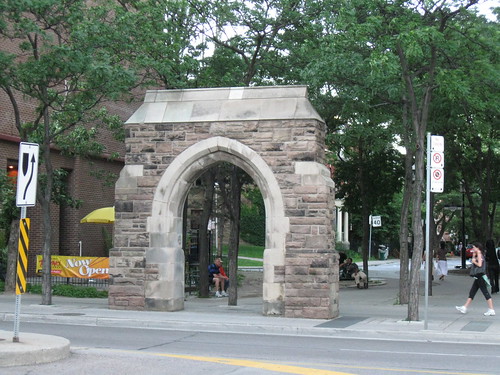It's unfortunate that a plaque wasn't attached to it, explaining its origin. I don't buy the explanation in the Toronto Life item that they were afraid of vandalism.
I was the Urban Decoder at the time. Took me for freaking ever to research that piece. Eventually I got through to the long-retired minister of the church at Yonge and Bloor from which the arch was salvaged. He was of a very advanced age - late 80s, I think, if not older - and an absolute delight to talk to. Thanks to the wonders of digitization, I still have the interview in my music library (iTunes, no less). Since I could never get details or texture like this into the Decoder, I thought I'd type it up. Here is the end of what he told me:
"When [the church] came down, some bright person from the department of works and buildings at the city felt this archway was an interesting archway. They asked the church if they could have it, and the church said, "certainly, if you wish. Take it away!"
They decided, "we would like to put it at the end of McGill, on Yonge." So we said, "That sounds fine to us. We'll put a bronze plate on it about where it came from." And they said, "Don't put a bronze plate on it down in that neighborhood. It'll be pried off the first night it's there!" The result was, they didn't ever put a mark on it. They talked about it, and in the end, they decided that what they'd like to do - but they never got permission and they never got round to doing it - was to get one of these people who inscribes gravestones. On the inside of the arch, you'll probably notice that there are some flat surfaces. And they'd put that the arch came from St Andrew's Church on Bloor Street and was moved there on the demolition of the church."
"Now there," he added. "I've given you the story."
I seem to also recall getting the explanation that Yonge St. in the mid-70s wasn't as genteel as it is now. Those who were there at the time would be better suited to weigh in on that than me. I was in contact with Heritage Toronto about this story, as well.
What was most remarkable at the time was the fact that *nobody* exactly knew where the arch came from - not the heritage department, not the BIA, not Kyle Rae himself, though they were all helpful. My foggy recollection is that Heritage Toronto had to look it up and get back to me, whereupon I had to go through the church, who found the retired minister. It's amazing how quickly history is lost, if you don't have a brass plaque to hold it in place.





